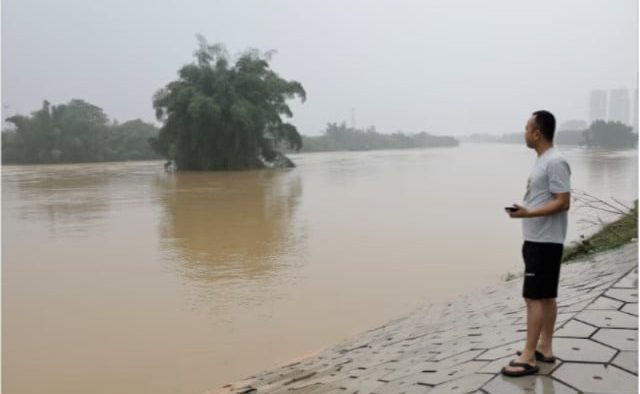Floods engulf southern China, raising concerns about catastrophic weather

Following record-breaking rainfall, floods submerged a few communities in the densely populated Pearl River Delta in southern China, raising concerns about the region’s defenses against larger deluges brought on by extreme weather occurrences.
In China’s flood-ravaged Guangdong province, rescuers in boats sped on Monday to free stranded residents, rescuing some elderly citizens from their houses on horseback and using helicopters to help locals buried in landslides.
Summer flooding is common in the province that was termed the “factory floor of the world” at one point. The worst downpours in Guangdong in 60 years battered the city in June 2022, severely testing its defenses against disruptive floods. Numerous thousands of individuals were taken out of danger.
Guangdong has been experiencing exceptionally high, persistent, and widespread rainfall since Thursday. Strong storms have also brought an earlier-than-normal start to the province’s yearly flooding season in May and June.
Residents in Qingyuan, a relatively small city of about 4 million people north of Guangzhou, the provincial capital, said they were nonetheless anxious even if the flooding over the weekend was not as bad as the floods in 2022.
Song Xiaowei, a worker at a firm that produces replacement components, expressed concern that the floods may be worse than they were two years ago.
“I’ve friends in Jintan town who have already removed their furniture. The village opposite that has been submerged to the first floor.”
Song stated that although his plant was still running normally, waterways were being watched in case they overflowed into the roadways.
According to him, one of the local rivers swelled as much as seven meters (23 feet), burying farms in the process.
The Bei River, which flows through Qingyuan and is a tributary of the Pearl River, exceeded its banks over the weekend, submerging several homes and businesses.
Videos posted on social media showed rescuers battling neck-high murky floods in some spots to free inhabitants, including an elderly woman stranded in waist-deep water inside an apartment complex.
Before 2022, Qingyuan resident Lin Xiuzheng, who worked in online retail sales, stated that the city never experienced as much flooding or as much rain as it does now.
According to scientists, climate change has made weather events in China more severe and unpredictable. Record-breaking rainfall and droughts have frequently struck the world’s second-largest economy at the same time.
In several areas of Guangdong, April precipitation records have already been shattered, and the towns of Shaoguan, Zhaoqing, and Jiangmen, which are located to the west and north of Guangzhou, are partially inundated in floodwaters.
Eleven persons in the province were unaccounted for on Monday morning, according to the state-run Xinhua News Agency, which carried the story without providing any further information. No fatalities were recorded in Guangdong.
According to Xinhua, the province suffered a direct economic loss of around 140.6 million yuan ($19.4 million) as a result of 36 houses collapsing and 48 suffering major damage.
There had been no immediate effect on business or supply lines, according to two enterprises in the province who spoke with Reuters.
“Everything’s running as usual and everyone got to work,” a caller from Camelot PCB, a print circuit board supplier to Tesla and other manufacturers of electric vehicles, stated.
Technology behemoths like Apple, Huawei, and Samsung are supplied by Polyrocks Chemical, a plastics manufacturer, which maintained that its operations were unaffected.
Nonetheless, Monday saw numerous rivers still over safety levels due to recent rainfall that was two to three times more than usual for this time of year.
Landslides in Shaoguan imprisoned locals, forcing helicopter rescues as other rescuers made their way on foot to isolated disaster locations.
Road clearance was also assisted by the Chinese military.
Although the rain stopped early on Monday, some province-wide schools were closed.
A stronger-than-normal subtropical high, a semi-permanent high-pressure system revolving north of the equator, was the source of the intense convective weather that was seen in southern China.
According to Chinese meteorologists, the stronger subtropical high caused higher temperatures that attracted more moisture-laden air from the South China Sea and even the Bay of Bengal, leading to severe precipitation.
After a brief break, thunderstorms are predicted to resume later in the week.

I am a dedicated student currently in my seventh semester, pursuing a degree in International Relations. Alongside my academic pursuits, I am actively engaged in the professional field as a content writer at the Rangeinn website.








